Balkinization
an unanticipated consequence of
Jack M. Balkin
Balkinization Symposiums: A Continuing List
E-mail:
Jack Balkin:
jackbalkin at yahoo.com
Bruce Ackerman
bruce.ackerman at yale.edu
Ian Ayres
ian.ayres at yale.edu
Corey Brettschneider
corey_brettschneider at brown.edu
Mary Dudziak
mary.l.dudziak at emory.edu
Joey Fishkin
joey.fishkin at gmail.com
Heather Gerken heather.gerken at yale.edu
Abbe Gluck abbe.gluck at yale.edu
Mark Graber
mgraber at law.umaryland.edu
Stephen Griffin
sgriffin at tulane.edu
Jonathan Hafetz
jonathan.hafetz at shu.edu
Jeremy Kessler
jkessler at law.columbia.edu
Andrew Koppelman
akoppelman at law.northwestern.edu
Marty Lederman
msl46 at law.georgetown.edu
Sanford Levinson
slevinson at law.utexas.edu
David Luban
david.luban at gmail.com
Gerard Magliocca
gmaglioc at iupui.edu
Jason Mazzone
mazzonej at illinois.edu
Linda McClain
lmcclain at bu.edu
John Mikhail
mikhail at law.georgetown.edu
Frank Pasquale
pasquale.frank at gmail.com
Nate Persily
npersily at gmail.com
Michael Stokes Paulsen
michaelstokespaulsen at gmail.com
Deborah Pearlstein
dpearlst at yu.edu
Rick Pildes
rick.pildes at nyu.edu
David Pozen
dpozen at law.columbia.edu
Richard Primus
raprimus at umich.edu
K. Sabeel Rahmansabeel.rahman at brooklaw.edu
Alice Ristroph
alice.ristroph at shu.edu
Neil Siegel
siegel at law.duke.edu
David Super
david.super at law.georgetown.edu
Brian Tamanaha
btamanaha at wulaw.wustl.edu
Nelson Tebbe
nelson.tebbe at brooklaw.edu
Mark Tushnet
mtushnet at law.harvard.edu
Adam Winkler
winkler at ucla.edu
Compendium of posts on Hobby Lobby and related cases
The Anti-Torture Memos: Balkinization Posts on Torture, Interrogation, Detention, War Powers, and OLC
The Anti-Torture Memos (arranged by topic)
Recent Posts
The Garland Fund and the Perils of Extremist Illiberalism
Just A Few Blogs
ACS Blog
Alas, a Blog
Althouse
Arts and Letters Daily
Atrios (Eschaton)
Bill of Health
Buzzflash.com
Buzz Machine
Cato at Liberty
Juan Cole (Informed Comment)
Concurring Opinions
The Constitution in 2020
Corrente
Crooked Timber
Daily Howler
Daily Kos
Dana Boyd
Brad DeLong
Digby (Hullabaloo)
Discriminations
Daniel Drezner
Kevin Drum (Mother Jones)
Electrolite
En Banc
Eunomia (Daniel Larison)
Fafblog
Michael Froomkin (Discourse.net)
GovLab (Beth Noveck)
Rick Hasen (Election Law)
History News Network
How Appealing
Ignatz (Sam Heldman)
The Importance of (Ernie Miller)
Infolaw
Instapundit
International Economic Law and Policy Blog
IntLawGrrls
Jacob Levy
Jesus' General
Jurisdynamics
The Kitchen Cabinet
Mark Kleiman
Law Blog Central
Larry Lessig
Lawyers, Guns and Money
Liberal Oasis
Brian Leiter's Law School Reports
The Leiter Reports
Marginal Revolution
Megan McArdle
Memeorandum
Metafilter
Mirror of Justice
The New Republic
Newseum
No More Mister Nice Blog
Brendan Nyhan
Opinio Juris
Orcinus
The Originalism Blog
Pandagon
Passport (Foreign Policy)
Overcoming Bias
Political Animal (Washington Monthly)
Political Theory Daily Review
Political Wire (Taegan Goddard)
The Poor Man
Virginia Postrel
Prawfsblawg
Public Reason
Jonathan Rauch
Raw Story
Redstate
ReligiousLeftLaw.com
Reporters Committee For Freedom of the Press
Reproductive Rights Blog
Rothman's Roadmap to the Right of Publicity
SCOTUS Blog
Seeing the Forest
Clay Shirky
The Shifted Librarian
The Situationist
Larry Solum (Legal Theory)
Andrew Sullivan
Talking Points Memo
Talk Left
Tapped
Tbogg
TechPresident
The Paper Chase (Jurist)
Tom Paine
Tom Tomorrow (This Modern World)
Eve Tushnet
Uggabugga
University of Chicago Law School Faculty Blog
Unqualified Offerings
The Volokh Conspiracy
War and Piece (Laura Rozen)
Wampum
Oliver Willis
Wonkette
Written Description
Matthew Yglesias
Yin
Your Choice of Feeds
1. XML
powered by
2. Atom Feed
3. RSS 2.0
The Garland Fund and the Perils of Extremist Illiberalism
Guest Blogger
For the Balkinization symposium on John Witt, The Radical Fund: How a Band of Visionaries and a Million Dollars Upended America (Simon and Schuster, 2025).
David E. Bernstein
John Fabian Witt’s The Radical Fund masterfully reconstructs the history of the
American Fund for Public Service, better known as the Garland Fund. The Fund
embodied both the promise and the peril of radical philanthropy in the United
States between World War I and World War II. Conceived by Roger Baldwin and
financed by Charles Garland’s relatively modest inheritance, the fund set out
to support “pioneering enterprises” capable of advancing democracy and social
justice (105–109). Yet the very inclusiveness that defined its mission proved
to be its undoing. Its openness blurred essential distinctions between liberal
reform and revolutionary activism, particularly the illiberal strains of the
latter promoted by American Communists who followed secret directives from the
USSR.
Baldwin assembled an extraordinary and eclectic board that included jurists
such as Felix Frankfurter, journalists like Freda Kirchwey, labor organizers
such as Sidney Hillman and Elizabeth Gurley Flynn, and one Communist, William
Z. Foster. The fund’s early grants to the ACLU, the NAACP, and Brookwood Labor
College reflected its founders’ belief that progress could be achieved through
education, litigation, and peaceful organizing. Baldwin described this as a
“mixture of forces” spanning the full left-liberal spectrum of American
politics (4).
The same inclusiveness that initially energized the fund soon produced deep
internal tensions. Baldwin, though willing to include a Communist perspective,
recognized the Party’s tendency to dominate institutions and warned that “one
Party member on the board was enough” (234). When Foster tried to send proxies
to board meetings, they were turned away. As late as 1926, Baldwin sought to
strengthen the anti-Communist faction within the board. In retaliation, the
Party derided the fund as “counter-revolutionary” and mocked Baldwin and
Socialist leader Norman Thomas as “a terrible bunch” (233–234).
Despite Baldwin’s efforts, Communist influence proved difficult to contain. The
fund’s commitment to pluralism left it vulnerable to what the Party itself
described as “boring from within” (234). By the mid-1920s, as liberal unions
weakened under employer pressure, Baldwin feared that disciplined Communists
might be the only radicals still capable of organizing workers effectively. The
situation grew more complicated after Baldwin’s 1927 visit to the USSR, where
he succumbed to Soviet propaganda and wrote an absurdly glowing book called “Liberty
Under the Soviets” before later resuming his criticism of Soviet repression.
The ideological tension intensified during the 1930s. The Great Depression
radicalized many on the left, including Charles Garland himself, who began
openly sympathizing with Communist causes. Although Garland lacked formal
authority, the directors felt morally obligated to respect his preferences, and
he used that leverage to advocate for grants to Party-backed initiatives. He
declared his “entire support and sympathy” for “left wing radical activities,”
such as Communist efforts to organize Black sharecroppers in the South (398).
Garland dismissed liberal projects like the NAACP’s legal work and Brookwood
Labor College as “right-wing movements,” pressing instead for aid to the
Communist-affiliated Workers’ School in New York (397–398). To him, only
revolutionary projects fulfilled the fund’s mission, a view other board members
saw as ideological capture.
By 1934, Garland’s radicalism had concrete consequences. Following the advice
of Party operatives Harold Ware and Lement Harris, the fund granted money to
Communist front organizations such as Farm Research, Inc., the Farmers’
National Committee for Action, and the Farmers’ National Weekly, a Party-linked
newspaper publicizing foreclosures and sharecroppers’ unions (398–399). These
grants redirected a significant share of the fund’s resources toward Party
causes.
The most audacious proposal came when Ware and Harris suggested laundering
Soviet funds through Amtorg, a Soviet trading company that also served as an
espionage conduit. Moscow would repay an old loan to a collective-farm
experiment, and the fund would then channel the disguised money to Harris’s
committee. This plan was blocked by Thomas, James Weldon Johnson, and
ex-Communist Ben Gitlow, who warned that aiding Harris would mean supporting
“Communist Party wrecking activities in the agricultural field” (399). Even so,
the damage had been done. After Ware’s death in 1935, Harris continued to use
Garland as a conduit for grants. As Witt notes, “two-thirds of the Fund’s new
gifts went to Party-run organizations in agriculture,” and in some years “every
new gift went to groups sponsored by Ware or Harris and endorsed by Garland”
(399).
The result was not a dramatic coup but a slow erosion of purpose. A fund
designed to democratize American capitalism had become, over time, a channel
for foreign-directed Communist objectives.
Witt resists reducing this story to mere gullibility. Instead, he portrays
individuals of sincerity and moral complexity. Baldwin’s “law of percentages,”
his belief that some experiments would yield “ideas valuable to mankind,”
captured both the courage and the naïveté of liberal idealism (4). The fund’s
liberal directors hesitated to impose ideological tests, fearing that exclusion
would betray their commitment to pluralism. Yet that very generosity became a
structural weakness when confronted by Stalinism’s demand for total conformity.
The openness that had nurtured contributions to genuine liberal achievements—such
as the ACLU’s free-speech litigation, the NAACP’s early legal strategy leading
to Brown v. Board of Education, and pioneering interracial unionism—also
enabled disciplined radicals to divert resources in the fund’s later years
(5–9, 398–399). In the end, the Garland Fund’s story reveals how liberal
pluralism can be exploited by followers of authoritarian ideologies. Its
leaders believed democracy would flourish by embracing all forms of dissent,
and that belief yielded both historic advances and moral confusion. They funded
defenders of liberty as well as some of its adversaries.
Witt’s account serves as both tribute and warning. It celebrates visionaries
who sought to dismantle “the bonds of old institutions” (9) while reminding
readers that liberal generosity can, if unchecked, become a surrender of
liberal judgment. The fund’s entanglement with Stalinism does not overshadow
its genuine contributions to civil liberties and racial justice, but it exposes
the risks of refusing to distinguish between progressive liberalism and manifestations
of authoritarianism on the left.
This history also clarifies why postwar liberals’ decision to distance
themselves from Communists, a move now sometimes derided as surrendering to the
Red Scare, was both morally justified and politically necessary. It cleared the
ground for the liberal achievements of the mid-twentieth century, including the
civil-rights movement and the Great Society programs.
Today, as liberal democracy again faces threats from multiple directions, the
Garland Fund’s story feels newly relevant. Illiberal forces on the left,
represented most prominently by mobs shouting “Globalized the Intifada” in
support of a terrorist theocracy, seek to undermine Western civilization to
promote “anti-colonialism” and other (misnamed) illiberal ideologies, while illiberal
forces on the right normalize racism and antisemitism under nationalist
banners. Those progressives and conservatives who value the liberal tradition
have more in common with each other than with the authoritarians on either
flank. Perhaps in the 1920s, a fund dedicated to assisting radical ideas was a
necessary innovation. Today, resources devoted to strengthening America’s
liberal core would be a welcome boost to efforts to ward off illiberal
extremists of all stripes.
Posted
9:30 AM
by Guest Blogger [link]
Books by Balkinization Bloggers

Linda C. McClain and Aziza Ahmed, The Routledge Companion to Gender and COVID-19 (Routledge, 2024)

David Pozen, The Constitution of the War on Drugs (Oxford University Press, 2024)

Jack M. Balkin, Memory and Authority: The Uses of History in Constitutional Interpretation (Yale University Press, 2024)
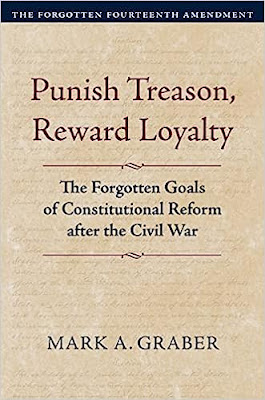
Mark A. Graber, Punish Treason, Reward Loyalty: The Forgotten Goals of Constitutional Reform after the Civil War (University of Kansas Press, 2023)
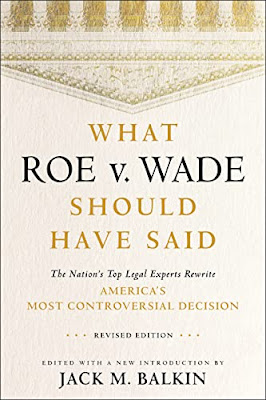
Jack M. Balkin, What Roe v. Wade Should Have Said: The Nation's Top Legal Experts Rewrite America's Most Controversial Decision - Revised Edition (NYU Press, 2023)

Andrew Koppelman, Burning Down the House: How Libertarian Philosophy Was Corrupted by Delusion and Greed (St. Martin’s Press, 2022)

Gerard N. Magliocca, Washington's Heir: The Life of Justice Bushrod Washington (Oxford University Press, 2022)
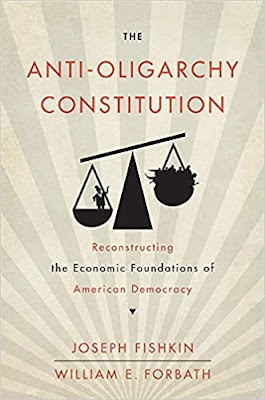
Joseph Fishkin and William E. Forbath, The Anti-Oligarchy Constitution: Reconstructing the Economic Foundations of American Democracy (Harvard University Press, 2022)
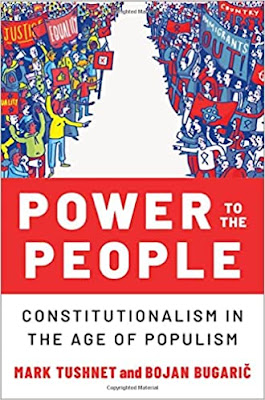
Mark Tushnet and Bojan Bugaric, Power to the People: Constitutionalism in the Age of Populism (Oxford University Press 2021).

Mark Philip Bradley and Mary L. Dudziak, eds., Making the Forever War: Marilyn B. Young on the Culture and Politics of American Militarism Culture and Politics in the Cold War and Beyond (University of Massachusetts Press, 2021).

Jack M. Balkin, What Obergefell v. Hodges Should Have Said: The Nation's Top Legal Experts Rewrite America's Same-Sex Marriage Decision (Yale University Press, 2020)

Frank Pasquale, New Laws of Robotics: Defending Human Expertise in the Age of AI (Belknap Press, 2020)

Jack M. Balkin, The Cycles of Constitutional Time (Oxford University Press, 2020)

Mark Tushnet, Taking Back the Constitution: Activist Judges and the Next Age of American Law (Yale University Press 2020).

Andrew Koppelman, Gay Rights vs. Religious Liberty?: The Unnecessary Conflict (Oxford University Press, 2020)

Ezekiel J Emanuel and Abbe R. Gluck, The Trillion Dollar Revolution: How the Affordable Care Act Transformed Politics, Law, and Health Care in America (PublicAffairs, 2020)

Linda C. McClain, Who's the Bigot?: Learning from Conflicts over Marriage and Civil Rights Law (Oxford University Press, 2020)
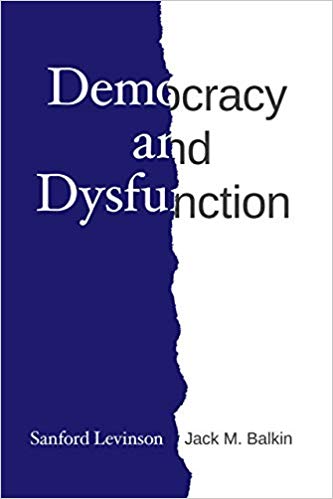
Sanford Levinson and Jack M. Balkin, Democracy and Dysfunction (University of Chicago Press, 2019)

Sanford Levinson, Written in Stone: Public Monuments in Changing Societies (Duke University Press 2018)

Mark A. Graber, Sanford Levinson, and Mark Tushnet, eds., Constitutional Democracy in Crisis? (Oxford University Press 2018)

Gerard Magliocca, The Heart of the Constitution: How the Bill of Rights became the Bill of Rights (Oxford University Press, 2018)

Cynthia Levinson and Sanford Levinson, Fault Lines in the Constitution: The Framers, Their Fights, and the Flaws that Affect Us Today (Peachtree Publishers, 2017)

Brian Z. Tamanaha, A Realistic Theory of Law (Cambridge University Press 2017)

Sanford Levinson, Nullification and Secession in Modern Constitutional Thought (University Press of Kansas 2016)

Sanford Levinson, An Argument Open to All: Reading The Federalist in the 21st Century (Yale University Press 2015)

Stephen M. Griffin, Broken Trust: Dysfunctional Government and Constitutional Reform (University Press of Kansas, 2015)

Frank Pasquale, The Black Box Society: The Secret Algorithms That Control Money and Information (Harvard University Press, 2015)

Bruce Ackerman, We the People, Volume 3: The Civil Rights Revolution (Harvard University Press, 2014)
Balkinization Symposium on We the People, Volume 3: The Civil Rights Revolution

Joseph Fishkin, Bottlenecks: A New Theory of Equal Opportunity (Oxford University Press, 2014)

Mark A. Graber, A New Introduction to American Constitutionalism (Oxford University Press, 2013)

John Mikhail, Elements of Moral Cognition: Rawls' Linguistic Analogy and the Cognitive Science of Moral and Legal Judgment (Cambridge University Press, 2013)

Gerard N. Magliocca, American Founding Son: John Bingham and the Invention of the Fourteenth Amendment (New York University Press, 2013)

Stephen M. Griffin, Long Wars and the Constitution (Harvard University Press, 2013)

Andrew Koppelman, The Tough Luck Constitution and the Assault on Health Care Reform (Oxford University Press, 2013)

James E. Fleming and Linda C. McClain, Ordered Liberty: Rights, Responsibilities, and Virtues (Harvard University Press, 2013)
Balkinization Symposium on Ordered Liberty: Rights, Responsibilities, and Virtues

Andrew Koppelman, Defending American Religious Neutrality (Harvard University Press, 2013)

Brian Z. Tamanaha, Failing Law Schools (University of Chicago Press, 2012)

Sanford Levinson, Framed: America's 51 Constitutions and the Crisis of Governance (Oxford University Press, 2012)

Linda C. McClain and Joanna L. Grossman, Gender Equality: Dimensions of Women's Equal Citizenship (Cambridge University Press, 2012)

Mary Dudziak, War Time: An Idea, Its History, Its Consequences (Oxford University Press, 2012)

Jack M. Balkin, Living Originalism (Harvard University Press, 2011)

Jason Mazzone, Copyfraud and Other Abuses of Intellectual Property Law (Stanford University Press, 2011)

Richard W. Garnett and Andrew Koppelman, First Amendment Stories, (Foundation Press 2011)

Jack M. Balkin, Constitutional Redemption: Political Faith in an Unjust World (Harvard University Press, 2011)

Gerard Magliocca, The Tragedy of William Jennings Bryan: Constitutional Law and the Politics of Backlash (Yale University Press, 2011)

Bernard Harcourt, The Illusion of Free Markets: Punishment and the Myth of Natural Order (Harvard University Press, 2010)

Bruce Ackerman, The Decline and Fall of the American Republic (Harvard University Press, 2010)
Balkinization Symposium on The Decline and Fall of the American Republic

Ian Ayres. Carrots and Sticks: Unlock the Power of Incentives to Get Things Done (Bantam Books, 2010)

Mark Tushnet, Why the Constitution Matters (Yale University Press 2010)
Ian Ayres and Barry Nalebuff: Lifecycle Investing: A New, Safe, and Audacious Way to Improve the Performance of Your Retirement Portfolio (Basic Books, 2010)
.jpg)
Jack M. Balkin, The Laws of Change: I Ching and the Philosophy of Life (2d Edition, Sybil Creek Press 2009)

Brian Z. Tamanaha, Beyond the Formalist-Realist Divide: The Role of Politics in Judging (Princeton University Press 2009)
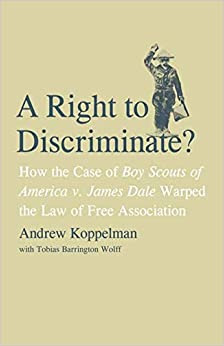
Andrew Koppelman and Tobias Barrington Wolff, A Right to Discriminate?: How the Case of Boy Scouts of America v. James Dale Warped the Law of Free Association (Yale University Press 2009)

Jack M. Balkin and Reva B. Siegel, The Constitution in 2020 (Oxford University Press 2009)
Heather K. Gerken, The Democracy Index: Why Our Election System Is Failing and How to Fix It (Princeton University Press 2009)

Mary Dudziak, Exporting American Dreams: Thurgood Marshall's African Journey (Oxford University Press 2008)

David Luban, Legal Ethics and Human Dignity (Cambridge Univ. Press 2007)

Ian Ayres, Super Crunchers: Why Thinking-By-Numbers is the New Way to be Smart (Bantam 2007)

Jack M. Balkin, James Grimmelmann, Eddan Katz, Nimrod Kozlovski, Shlomit Wagman and Tal Zarsky, eds., Cybercrime: Digital Cops in a Networked Environment (N.Y.U. Press 2007)
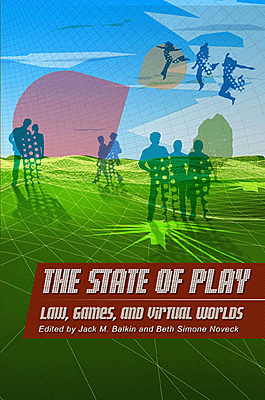
Jack M. Balkin and Beth Simone Noveck, The State of Play: Law, Games, and Virtual Worlds (N.Y.U. Press 2006)

Andrew Koppelman, Same Sex, Different States: When Same-Sex Marriages Cross State Lines (Yale University Press 2006)
Brian Tamanaha, Law as a Means to an End (Cambridge University Press 2006)
Sanford Levinson, Our Undemocratic Constitution (Oxford University Press 2006)
Mark Graber, Dred Scott and the Problem of Constitutional Evil (Cambridge University Press 2006)
Jack M. Balkin, ed., What Roe v. Wade Should Have Said (N.Y.U. Press 2005)
Sanford Levinson, ed., Torture: A Collection (Oxford University Press 2004)
Balkin.com homepage
Bibliography
Conlaw.net
Cultural Software
Writings
Opeds
The Information Society Project
BrownvBoard.com
Useful Links
Syllabi and Exams